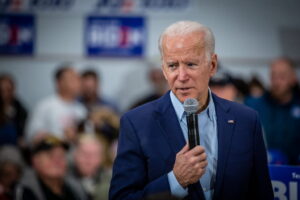by The Cowl Editor on January 16, 2020
National and Global News

by Alexandra Huzyk ’20
News Staff
The next United States presidential elections are scheduled to take place on Nov. 3, prompting voters to consider a number of diverse candidates. As of January 2020, there are 12 major Democratic candidates, and three major Republican candidates, including incumbent President Donald Trump.
The eighth, ninth, and tenth Democratic primary debates are scheduled to take place throughout February. These debates help to inform voters, promote accountability of elected officials, and progressively narrow down the number of candidates running for the Democratic nomination. Past debates have pressed candidates to address important issues like healthcare, education, gun violence, inequality, and war. The Democratic primary will likely be settled on Super Tuesday—March 3, 2020—“when the largest number of states and territories hold a presidential preference primary or caucus.”
Front-runners for the Democratic nomination currently include Joe Biden, Bernie Sanders, Pete Buttigieg, Elizabeth Warren, and Amy Klobuchar. Many predict Biden will be the nominee for the Democratic Party; having maintained consistently strong African-American support, continuing to receive a multitude of endorsements, and polling the best against President Trump. According to political Analyst Nate Silver, “Should Joe Biden win Iowa, he has an 80 percent chance of becoming the nominee.”
In the wake of these predictions, Sanders has gained momentum within the past months, receiving $34.5 million in the last fundraising quarter and garnering strong support from younger generations and public sector union members. However, Sanders’ democratic socialist views pose an issue for Democrats who think a more politically moderate candidate has a greater chance of winning against President Trump. In addition, many view Sanders’ age (77) and health as potentially problematic.
In the opposing party, candidates who seek to attain the Republican nomination include incumbent President Donald Trump, Joe Walsh, and William F. Weld. Even after having been recently impeached, for abuse of power and obstruction of Congress, President Donald Trump remains the primary Republican presidential candidate. The chances of either Walsh or Weld being granted this nomination are extremely low.
Although presidential approval ratings of Trump have remained notoriously low throughout his time in office, it is reported that he has around a 40% chance of being reelected to office. These chances of reelection may be explained by the decreasing unemployment rate and increasing GDP growth rates, which some attribute to the work of Trump’s presidency.
Historically, 17 of 44 presidents have been reelected for a second term. On the power of incumbency, Aaron David Miller, an academic at the Carnegie Endowment for International Peace, has said, “As President Trump has demonstrated with frightening clarity, presidents dominate the national and media narratives; we see or hear them daily, in Trump’s case often hourly.”
A number of different factors will continue to influence the likelihood of Trump’s reelection, including the upcoming impeachment trial in the Senate and the recently initiated military conflict with Iran.